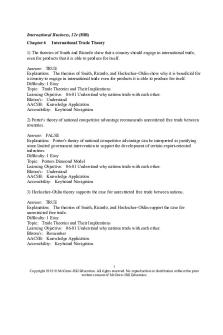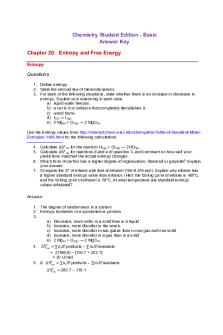Chem Basic FB Answer Key Ch 20 (06 PDF

| Title | Chem Basic FB Answer Key Ch 20 (06 |
|---|---|
| Author | Candice Lau |
| Course | Introductory Chemistry |
| Institution | University of Queensland |
| Pages | 4 |
| File Size | 202.8 KB |
| File Type | |
| Total Downloads | 41 |
| Total Views | 133 |
Summary
-----...
Description
Chemistry Student Edition - Basic Answer Key Chapter 20: Entropy and Free Energy Entropy
Questions 1. Define entropy. 2. State the second law of thermodynamics. 3. For each of the following situations, state whether there is an increase or decrease in entropy. Explain your reasoning in each case. a) liquid water freezes. b) a car is in a collision that completely demolishes it. c) wood burns. d) I2(s) → I2(g). e) 2 Mg(s) + O2(g) → 2 MgO(s). Use the entropy values from http://chemed.chem.wisc.edu/chempaths/Table-of-Standard-MolarEntropies-1184.html for the following calculations: 4. Calculate ΔS°rxn for the reaction H2(g) + Cl2(g) → 2HCl(g). 5. Calculate ΔS°rxn for reactions d and e of question 3, and comment on how well your predictions matched the actual entropy changes. 6. Which form of carbon has a higher degree of organization: diamond or graphite? Explain your answer. 7. Compare the S° of ethane with that of ethanol (159.9 J/K•mol). Explain why ethane has a higher standard entropy value than ethanol. (Hint: the boiling point of ethane is -89°C, and the boiling point of ethanol is 78°C. At what temperature are standard entropy values tabulated? Answers 1. The degree of randomness in a system 2. Entropy increases in a spontaneous process 3. a) Decrease, more order in a solid than in a liquid b) Increase, more disorder in the wreck c) Increase, more disorder in two gases than in one gas and one solid d) Increase, more disorder in a gas than in a solid e) 2 Mg(s) + O2(g) → 2 MgO(s). 4.
o ΔSrxn = ∑npS°products – ∑mrS°reactants
= 2(186.9) – [130.7 + 223.1] = 20 lJ/mol 5. d. ΔSorxn = ∑npS°products – ∑mrS°reactants
ΔSorxn = 260.7 – 116.1
= 114.6 kJ/mol entropy increased as predicted e. ΔS = 2(26.9) – [2(32.7) + 205.1] = 53.8 – (65.4 + 205.1) = -261.7 entropy decreased as predicted 6. Diamond has a higher degree of organization. Its entropy value is lower than that of graphite (2.277 for diamond as compared to 5.6 for graphite) 7. The So for ethane is 229.kJ/mol. Ethane has a higher degree of disorder, even though it has a somewhat lower molecular weight. The –OH groups of ethanol can hydrogenbond to one another and provide more order than then individual ethane molecules. o rxn
Spontaneous Reactions and Free Energy
Questions 1. 2. 3. 4. 5. 6. 7. 8.
What thermodynamic quantities are used to define Gibbs free energy? Define each component of the equation describing Gibbs free energy. What is true for all spontaneous processes regarding Gibbs free energy equation? What is the change in Gibbs free energy for the formation of any element in its most stable state at 25°C? What can be inferred from a very large ΔGrxn? From a very small ΔGrxn? What does a ΔG value of zero imply? Describe how it is possible that a reaction is spontaneous at some temperatures but not at others. Use the table at http://chemed.chem.wisc.edu/chempaths/GenChem-Textbook/TheFree-Energy-629.html to calculate ΔG°rxn for the following reactions at 25°C: a) CaCO3(s) → CaO(s) + CO2(g) b) 2Mg(s) + O2(g) → 2MgO(s) c) 2SO2(g) + O2(g) → 2SO3(g) d) 2C2H6(g) + 7O2(g) → 4CO2(g) + 6H2O(l)
Answers 1. 2. 3. 4. 5. 6. 7. 8.
Gibbs free energy combines entropy and enthalpy H is enthalpy, a measure of heat. S is entropy, a measure of disorder. T is temperature. Spontaneous processes have negative Gibbs free energy. The Gibbs free energy change for a formation of an element in its most stable state is zero at 25°C. A large ΔGrxn implies a reaction is strongly favored (or disfavored, if ΔG>0). A small ΔG means the reaction is not strongly favored. A ΔG of zero implies a reaction is at equilibrium. As temperature increases, entropy plays a larger role in determining the spontaneity of a reaction; this sometimes causes reactions to no longer be spontaneous. Use the table at http://chemed.chem.wisc.edu/chempaths/GenChem-Textbook/TheFree-Energy-629.html to calculate ΔG°rxn for the following reactions at 25°C: a) ∆Greaction = [-604.3 -394.4] – (-1128.79) = - 998.7 + 1128.79 = 130.1 kJ/mol b) ∆Greaction = 2(-569.43) – [2(0) + 0] = -1138.86 kJ/mol
c) ∆Greaction = 2(-371.06) – [2(-300.094) + 0] = - 742.12 + 600.19 = - 141.93 kJ/mol d) ∆Greaction = [4(-394.359) + 6(-237.129) –[2(-32.84) + 7(0)] note that water is a liquid in this reaction = -3000.21 + 65.68 = -2934.53 kJ/mol
Factors Affecting Chemical Equilibria
Questions 1. What is the difference between the equilibrium constant and the reaction quotient? 2. In which direction will the reaction proceed based on the three following conditions? a) Q>Keq b) Q...
Similar Free PDFs

Ch.10 Key Meiosis - answer key
- 11 Pages

Ch 8 Answer KEY Articulations
- 7 Pages

Hill12e Chapter 06 TB Answer Key
- 44 Pages

Chem 111 Ch 20 Nuclear Chemistry
- 23 Pages

Hill12e Chapter 20 TB Answer Key
- 49 Pages

IT Audit Ch 4 - Answer key
- 27 Pages

IT Audit Ch 3 - Answer key
- 17 Pages

IT Audit Ch 5 - Answer Key
- 5 Pages
Popular Institutions
- Tinajero National High School - Annex
- Politeknik Caltex Riau
- Yokohama City University
- SGT University
- University of Al-Qadisiyah
- Divine Word College of Vigan
- Techniek College Rotterdam
- Universidade de Santiago
- Universiti Teknologi MARA Cawangan Johor Kampus Pasir Gudang
- Poltekkes Kemenkes Yogyakarta
- Baguio City National High School
- Colegio san marcos
- preparatoria uno
- Centro de Bachillerato Tecnológico Industrial y de Servicios No. 107
- Dalian Maritime University
- Quang Trung Secondary School
- Colegio Tecnológico en Informática
- Corporación Regional de Educación Superior
- Grupo CEDVA
- Dar Al Uloom University
- Centro de Estudios Preuniversitarios de la Universidad Nacional de Ingeniería
- 上智大学
- Aakash International School, Nuna Majara
- San Felipe Neri Catholic School
- Kang Chiao International School - New Taipei City
- Misamis Occidental National High School
- Institución Educativa Escuela Normal Juan Ladrilleros
- Kolehiyo ng Pantukan
- Batanes State College
- Instituto Continental
- Sekolah Menengah Kejuruan Kesehatan Kaltara (Tarakan)
- Colegio de La Inmaculada Concepcion - Cebu







